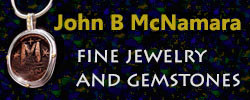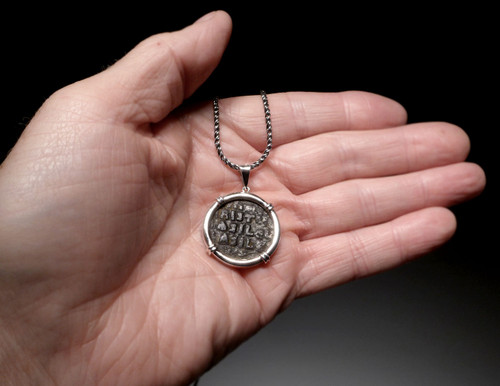Product Description
This beautiful, large ancient bronze Byzantine follis coin features a rare, crisply detailed image of Jesus Christ holding the Bible. It is set in a 14KY gold pendant setting which perfectly compliments very rare, PRIZED mint green patina. This coin is called an anonymous bronze follis because the ruling emperor was not depicted on the obverse but instead, Christ. It has been mounted to display the side showing Jesus holding a Bible to His chest. The reverse shows a bold inscription in Greek (the common language of the day of Byzantine Roman Empire), "IhSUS XRISTUS bASILEU bASILE" which translates to "Jesus Christ, King of Kings". An impressive antiquity of ancient Christianity and highly recommended. This coin was minted under the rule of Basil II and Constantine VIII and dates between 1023 A.D. and 1028 A.D..
As a modern representative of one's Christian beliefs, wearing a pendant featuring one of these genuine ancient Christian Roman coins is a far more unique display of one's faith compared to a modern made, mass-produced cross on a chain.
ADD THE DISPLAYED GOLD THICK FORSANTINA CHAIN
SEE MORE ANCIENT BYZANTINE ROMAN COIN JEWELRY
HISTORY
The anonymous bronze follis series was a revolutionary design in Byzantine coinage. For countless centuries even dating back to the early Roman Empire, coins always featured an emperor and promoted the emperor's rule. As Christianity dominated the Roman Byzantine Empire, a break from tradition was instituted in their coin follis issues to purposely promote Christ and not a man, not even the emperor himself during his own rule. This was in keeping with Christian beliefs that man is insignificant in the light of God and no man should be worshipped but God alone. These coins typically feature an image of Christ looking straight at you on the obverse side with the reverse boldly written in Greek, "In Christ, Victory" or "Jesus Christ, King of Kings".
As a result of the Byzantine coinage reform carried out at the end of the fifth century AD, a whole new range of denominations was brought into being each clearly marked with it’s value as a multiple of the basic ‘nummus’. The Christian religion that permeated the Byzantine culture influenced decisions to use Greek numerals for the new coins as Greek was the language of the New Testament. The largest denomination, the FOLLIS, bore the mark of value “M” (40 nummi), the HALF FOLLIS “K” (20 nummi), the DECANUMIUM “I” (10 nummi), and the PENTANUMIUM “E” (5 nummi), introduced at a later period. Over time, imagery used on the Byzantine coinage became increasingly religious. A portrait of Christ first appears on coinage of Justinian II (685-695 AD). Religious images were later banned in 815 AD during the Iconoclastic Period but restored in 843 AD under the empress Theodora.
 US Dollars
US Dollars
 AUD
AUD
 CAD
CAD
 POUNDS STERLING
POUNDS STERLING












